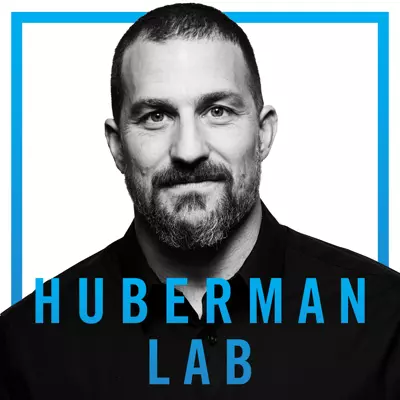The Huberman Lab Podcast discusses neuroscience: how our brain and its connections with the organs of our body control our perceptions, our behaviors, and our health. We also discuss existing and emerging tools for measuring and changing how our nervous system works. Dr. Andrew Huberman is a tenured Professor of Neurobiology and Ophthalmology at Stanford School of Medicine. His laboratory studies neural regeneration, neuroplasticity, and brain states such as stress, focus, fear, and optimal performance. For more than 20 years, Dr. Huberman has consistently published original research findings and review articles in top-level peer-reviewed journals, including Nature, Science, Cell, Neuron, and Current Biology. He is a regular member of several National Institutes of Health review panels and a Fellow of the McKnight Foundation and the Pew Charitable Trusts. Dr. Huberman regularly consults for technology development companies, professional athletic organizations, and various units of U.S. and Canadian Special Operations.
How to Control Your Sense of Pain & Pleasure | Episode 32
This episode I discuss our sense of pain and pleasure: where and how they each arise in our mind and body and various ways to control their intensity. I discuss the science of behavioral tools like acupuncture and hypnosis and directed pressure, including the neural circuits they each activate to modulate our experience of pain or pleasure. I also discuss whole body pain, pain "syndromes" and novel pain relief compounds such as Acetyl-L-Carnitine, SAMe and Agmatine. I discuss neuroplasticity of the pain system and the key role that visual perception plays in pain modulation. Finally, I address the link between dopamine, serotonin, and oxytocin, with arousal, pleasure and pain. As always, both basic science and various protocols are described.
Note: The description of the dorsal root ganglia (DRGs) was intentionally simplified and does not include mention of dorsal horn spinal relay neurons, etc. For an excellent full text review of this anatomy and circuits for touch sensing, please see: https://bit.ly/3jH9CPf
Thank you to our sponsors:
- InsideTracker - https://www.insidetracker.com/huberman
- Helix Sleep - https://www.helixsleep.com/huberman
- Athletic Greens - https://www.athleticgreens.com/huberman
Our Patreon page:
Supplements from Thorne:
Social:
- Instagram - https://www.instagram.com/hubermanlab
- Twitter - https://twitter.com/hubermanlab
- Facebook - https://www.facebook.com/hubermanlab
- Website - https://hubermanlab.com
- Join the Neural Network - https://hubermanlab.com/neural-network
Links:
- Instagram discussion with Dr. Sean Mackey, MD, PhD - https://www.instagram.com/p/CMVq0X8Bk1D/
- Agmatine study - https://bit.ly/3CtTwRn
- Mechanistic basis of acupuncture - https://bit.ly/2VHi0pz
Timestamps:
- 00:00:00 Skin, Pain, Pleasure
- 00:01:50 Protocol 1: Maximizing Motivation (with Dopamine & Pleasure)
- 00:07:12 Sponsors: InsideTracker, Helix Sleep, Athletic Greens
- 00:12:04 Pleasure & Pain, & Skin Sensors
- 00:18:13 Sensing Touch with Your Brain: Magnification of Feet, Hands, Lips, Face, Genitals
- 00:22:16 Two-Point Discrimination, Dermatomes
- 00:28:11 Thoughts & Genes That Make Physical Pain Worse
- 00:33:45 Expectations, Anxiety, & Pain Threshold
- 00:40:27 Protocol 2: Cold Sensing Is Relative; Getting Into Cold Water
- 00:45:22 Protocol 3: Heat Is Absolute
- 00:48:10 Injury & Pain
- 00:52:04 Protocol 4: Plasticity of Pain: Key Role of Vision
- 00:58:08 Sensing Disparate Body Parts As Merged
- 01:01:00 Pain “Syndromes”, Psychogenic Fever, “Psychosomatics”
- 01:04:40 Fibromyalgia, Naltrexone, Protocol 5: Acetyl-L-Carnitine
- 01:12:24 Protocol 6: Agmatine, S-adenosyl-L-methionine (SAMe), L-5-Methyltetrahydrofolate*
- 01:17:27 Acupuncture: Mechanism, Non-Responders, Itch & Inflammation
- 01:28:20 Laser Photobiomodulation, Protocol 7: Hypnosis (reveri.com)
- 01:30:00 Protocol 8: Pressure-Based Pain Relief, “Gate Theory of Pain (Relief)”
- 01:37:53 Redheads & Pain Thresholds, Endogenous Opioids
- 01:44:02 Protocol 8: Love & Pain, Dopamine
- 01:49:23 Pleasure & Reproduction, Dopamine & Serotonin, Oxytocin
- 01:51:40 Protocol 9: PEA, L-Phenylalanine (Precursor to Tyrosine)
- 01:55:40 Contextual Control of Pleasure by Autonomic Arousal, Dopamine Baselines
- 01:59:40 Pleasure-Pain Balance
- 02:01:24 Protocol 10: Controlling Pleasure, Dopamine & Motivation Over Time
- 02:06:40 Protocol 11: Immediate, Non-Goal-Directed Pleasure, PAG
- 02:08:40 Direction of Touch: Pleasure Versus Pain, Arousal & Touch “Sensitivity”
- 02:13:00 Synthesis & How to Conceptualize Pain and Pleasure, Support
